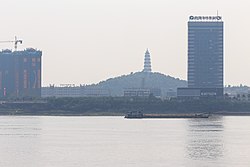Gaoyao 高要区 Koyiu | |
|---|---|
 | |
 Location of Gaoyao (red) within Zhaoqing City and Guangdong province | |
| Coordinates: 23°02′N112°27′E / 23.033°N 112.450°E | |
| Country | People's Republic of China |
| Province | Guangdong |
| Prefecture-level city | Zhaoqing |
| Area | |
• Total | 2,206 km2 (852 sq mi) |
| Population (2020 census) | |
• Total | 741,591 |
| • Density | 340/km2 (870/sq mi) |
| Time zone | UTC+8 (China Standard) |
| Gaoyao, Zhaoqing | |||||||||||||
|---|---|---|---|---|---|---|---|---|---|---|---|---|---|
| Chinese | 高要 | ||||||||||||
| Postal | Koyiu | ||||||||||||
| |||||||||||||
Gaoyao,alternately romanized as Koyiu,is an urban district of Zhaoqing in western Guangdong,China. Its population in 2020 was 741,591. [1]
Contents
- Name
- Geography
- Climate
- History
- Culture and people
- Tourism
- Image gallery
- Administrative divisions
- References
- Citations
- Bibliography
- External links



